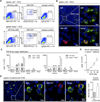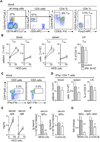Innate response activator B cells aggravate atherosclerosis by stimulating T helper-1 adaptive immunity
- PMID: 24488984
- PMCID: PMC3997655
- DOI: 10.1161/CIRCULATIONAHA.113.006381
Innate response activator B cells aggravate atherosclerosis by stimulating T helper-1 adaptive immunity
Abstract
Background: Atherosclerotic lesions grow via the accumulation of leukocytes and oxidized lipoproteins in the vessel wall. Leukocytes can attenuate or augment atherosclerosis through the release of cytokines, chemokines, and other mediators. Deciphering how leukocytes develop, oppose, and complement each other's function and shape the course of disease can illuminate our understanding of atherosclerosis. Innate response activator (IRA) B cells are a recently described population of granulocyte macrophage colony-stimulating factor-secreting cells of hitherto unknown function in atherosclerosis.
Methods and results: Here, we show that IRA B cells arise during atherosclerosis in mice and humans. In response to a high-cholesterol diet, IRA B cell numbers increase preferentially in secondary lymphoid organs via Myd88-dependent signaling. Mixed chimeric mice lacking B cell-derived granulocyte macrophage colony-stimulating factor develop smaller lesions with fewer macrophages and effector T cells. Mechanistically, IRA B cells promote the expansion of classic dendritic cells, which then generate interferon γ-producing T helper-1 cells. This IRA B cell-dependent T helper-1 skewing manifests in an IgG1-to-IgG2c isotype switch in the immunoglobulin response against oxidized lipoproteins.
Conclusions: Granulocyte macrophage colony-stimulating factor-producing IRA B cells alter adaptive immune processes and shift the leukocyte response toward a T helper-1-associated milieu that aggravates atherosclerosis.
Keywords: B-lymphocytes; T-lymphocytes; atherosclerosis; dendritic cells; granulocyte-macrophage colony-stimulating factor; immunology.
Conflict of interest statement
Figures






References
-
- Ait-Oufella H, Salomon BL, Potteaux S, Robertson AK, Gourdy P, Zoll J, Merval R, Esposito B, Cohen JL, Fisson S, Flavell RA, Hansson GK, Klatzmann D, Tedgui A, Mallat Z. Natural regulatory T cells control the development of atherosclerosis in mice. Nat Med. 2006;12:178–180. - PubMed
-
- Herbin O, Ait-Oufella H, Yu W, Fredrikson GN, Aubier B, Perez N, Barateau V, Nilsson J, Tedgui A, Mallat Z. Regulatory T-cell response to apolipoprotein B100-derived peptides reduces the development and progression of atherosclerosis in mice. Arterioscler Thromb Vasc Biol. 2012;32:605–612. - PubMed
-
- Klingenberg R, Gerdes N, Badeau RM, Gistera A, Strodthoff D, Ketelhuth DF, Lundberg AM, Rudling M, Nilsson SK, Olivecrona G, Zoller S, Lohmann C, Luscher TF, Jauhiainen M, Sparwasser T, Hansson GK. Depletion of FOXP3+ regulatory T cells promotes hypercholesterolemia and atherosclerosis. J Clin Invest. 2013;123:1323–1334. - PMC - PubMed
-
- Kyaw T, Tay C, Krishnamurthi S, Kanellakis P, Agrotis A, Tipping P, Bobik A, Toh BH. B1a B lymphocytes are atheroprotective by secreting natural IgM that increases IgM deposits and reduces necrotic cores in atherosclerotic lesions. Circ Res. 2011;109:830–840. - PubMed
Publication types
MeSH terms
Substances
Grants and funding
LinkOut - more resources
Full Text Sources
Other Literature Sources
Medical
Molecular Biology Databases

